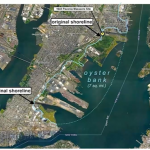New Jersey Future Blog
NJ Should Get to Work Making it Easier to Get to Work
November 24th, 2008 by Tim Evans
- About 10 percent of New Jersey commuters ride transit to work, the second-highest rate among the 50 states, after New York. But when commutes to locations outside the state (primarily New York and Philadelphia) are removed from the equation, only 5 percent of people working within New Jersey take transit to work—no better than the national average.
- Job growth in New Jersey since 1980 has taken place mainly in automobile-dependent locations, while older, transit-accessible job centers have declined. The 20 biggest job-gaining municipalities between 1980 and 2003 feature a combined transit commuting rate of 7.2 percent; if Jersey City is removed from the analysis, this further drops to only 4 percent, while four out of five commuters (81.7 percent) drove alone. Meanwhile, the 20 biggest job-losing municipalities together boasted a much higher 11.7 percent rate of workers commuting by transit, with only two-thirds (67.9 percent) driving to work alone.
- Commutes are longer in New Jersey than in most other states, and getting longer faster. New Jersey’s average travel time to work, 30 minutes as of the 2000 Census, is the nation’s third-longest, and represents an increase of 4.7 minutes over the 1990 average—the third-largest increase in the country.
Job Sprawl Follows Residential Sprawl
New Jersey has one of the best and most extensive rail transit systems in the country. And the huge concentrations of employment in New York and Philadelphia enable large numbers of New Jerseyans to commute conveniently by transit to jobs in those cities (70 percent of all New Jersey residents who work in Manhattan commute by transit). But these transit-enabling job densities are harder to find within the state’s own borders.
The distribution of employment in New Jersey has changed dramatically since 1980; many of the state’s job centers of the past have declined in importance, eclipsed by new clusters of suburban office parks. Most of the newer job centers—places like Parsippany, Bridgewater and Mount Laurel—are not well served by public transportation, meaning that each of their workers represents an additional car on the road, adding to congestion.
Over the same time period, many older job centers with good transit access—places like Newark, Paterson and Camden—have been losing jobs, reducing the number of people who have the option of commuting by means other than their car. These urban municipalities, already plagued by a host of socioeconomic challenges, are also the very places where jobs are most needed to build the tax base and provide employment opportunities for residents.
The movement of jobs away from transit-accessible urban centers and out into automobile-dependent suburban locations mirrors the pattern of our residential development; job sprawl is following housing sprawl. This produces an omnidirectional rush hour that inhibits transit service, whose success relies on the spatial concentration of activity. As more and more workers are effectively forced to drive alone to work, traffic gets worse and commutes get longer. This job sprawl also undermines recently articulated state policy goals regarding the reduction of greenhouse-gas emissions, since every new job created in a car-dependent office park means one more car on the road, emitting more CO2, and one less potential transit commuter or walker.
Reconnecting Jobs With Transit
Steering jobs back to transit- and pedestrian-friendly locations would allow New Jersey to take advantage of its extensive public transportation system and get commuters out of their cars and onto trains and buses (or onto the sidewalks), thereby reducing congestion, per-capita energy consumption and greenhouse-gas emissions. This recentralization strategy would also give a much-needed economic boost to some of the state’s struggling urban areas by creating employment opportunities where they are most needed and by shoring up these municipalities’ commercial tax bases, generating revenues that could be used to improve local services.
A new report by New Jersey Future, Getting to Work: Reconnecting Jobs with Transit, recommends several steps the state could take to reduce the stress and frustration of commuting, and advance several progressive public policy goals, by employing strategies to link job sites with public transportation. These recommendations include:
- Providing incentives for development and/or redevelopment around transit stations by assisting with environmental cleanup of nearby properties, prioritizing infrastructure investments in targeted transit hubs, addressing concerns about public safety and service quality in municipalities experiencing socioeconomic distress, and providing staff resources and financial aid to encourage municipalities to change their zoning to accommodate station-area development.
- Reorienting the state’s business recruitment programs by adopting an explicit goal of encouraging large employers to locate near transit stations.
- Leveling the playing field between transit and driving by eliminating the hidden subsidies and incentives (such as the nation’s third-lowest gasoline tax) for automobile use while transit fares steadily increase.
Making the reduction of vehicle miles traveled (VMT)—and the expansion of transit ridership—explicit goals of state efforts to curb greenhouse gas emissions.
If you have any questions about this issue of Future Facts, please contact Tim Evans, Research Director.
















